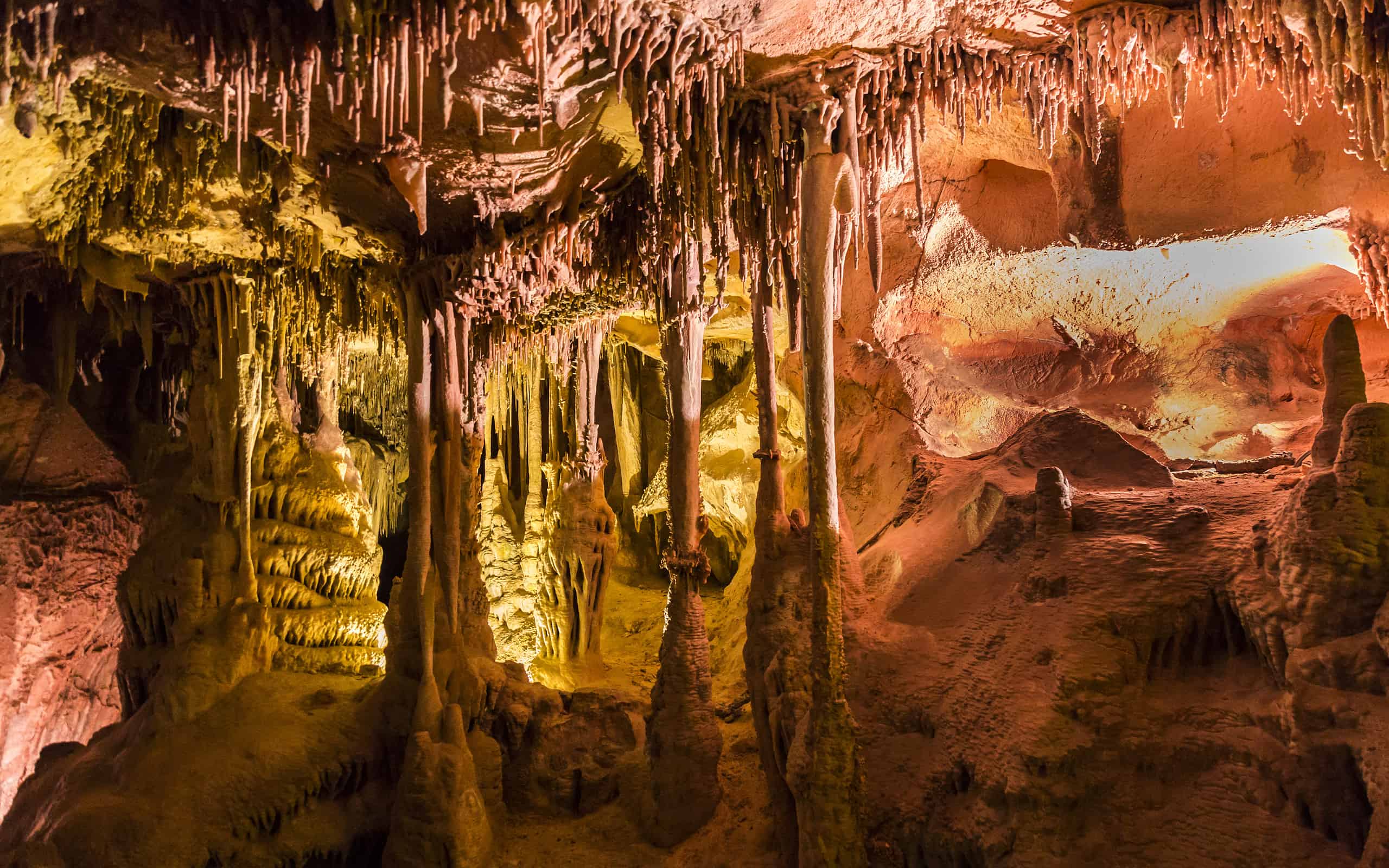While Nevada may be better known for Sin City and Area 51, the Silver State offers some incredible caving experiences. You can find these amazing 10 caves in Nevada fairly easily in most cases. Some have tours, though most are free-wheeling caves where you’re on your own to find them and explore.
Explore the natural beauty of the state, like lakes and rivers, but be sure to look out for the many hidden gems of caves in Nevada for your unusual adventures unlike most friends’ visits here.

Lehman Caves
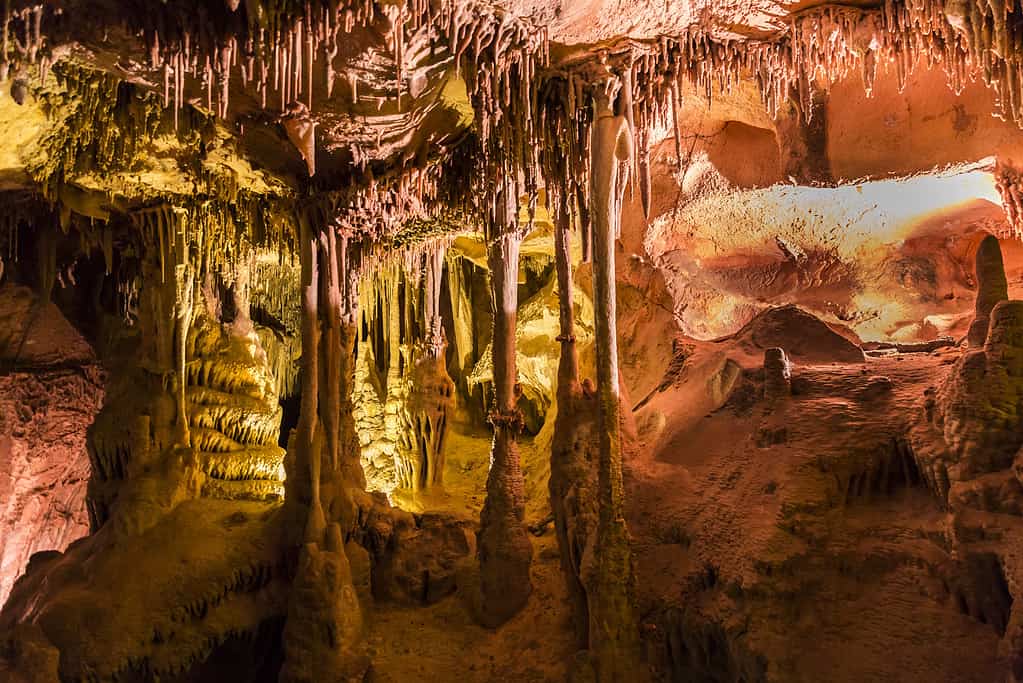
Tours lead folks through well-decorated Lehman Caves in Great Basin National Park, Nevada. You’ll be amazed at the glorious scenery, just as tourists were all the way back in the 1880s when tours first began.
©frontpoint/ via Getty Images
The longest cave system in all of Nevada, Lehman Caves has become one of the most well-known and popular destinations in the state. Tours for the cave actually began in 1885 and continue today via ranger-guided tours. To visit the cave now, you must have tickets for one of the tours.
The gorgeous cave was first discovered by Absalom Lehman in the 1880s when he felt an oddly cool breeze coming from the ground. He climbed through a small natural entrance and discovered the stunning stalactites and stalagmites within. Soon after, he began offering the first tours of the caves. Today, tours last between 60 and 90 minutes, depending on your taste.
Explore the caves during one of two tours offered during the summer months. The Lodge Room tours run during winter as well as summer, while the Grand Palace tour only goes in the summertime. To enjoy the tours, be sure to book well in advance as they sell out quickly.
Spirit and Hidden Caves Archaeological Site

Great Basin National Park is a United States National Park located in White Pine County in east-central Nevada, near the Utah border.
At Grimes Point, in Hidden Cave or Spirit Cave Archaeological Site, you’ll find plenty of excitement for your caving aspirations. The cave, located in the foothills of the Stillwater Mountains, once held two sets of mummies discovered in 1940. One has become known as the Spirit Cave Mummy, dating back at least 9,000 years and the oldest in North America. Numerous artifacts accompanied the mummies, though many only date as far back as 2000 years ago.
Hidden Cave was first excavated in the 1930s when Mark Harrington “discovered” it and began his explorations. He named the cave “Hidden” because of his difficulty in finding it originally and ongoing, unless extremely attentive. This cave dates back with artifacts at least 3500 years old.
Grimes Point, where the caves exist, also offers many intriguing points. The Point is a field of basalt boulders, covered in glossy black desert varnish. Petroglyphs on the rocks may be observed from walking trails.
Toquima Cave
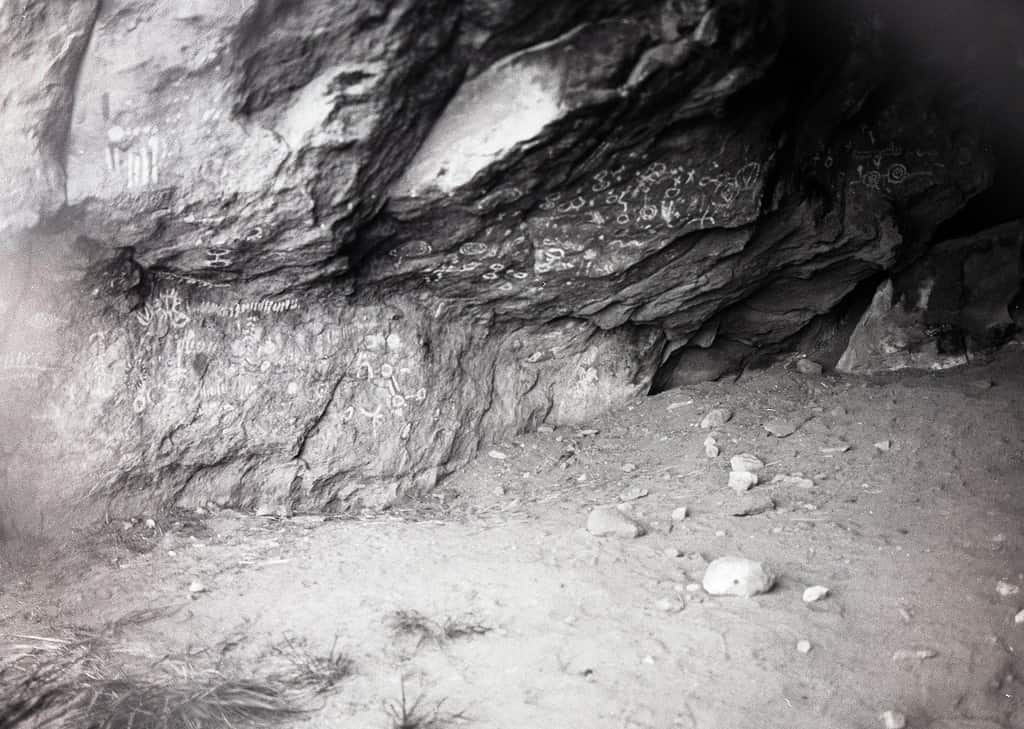
Toquima Cave Petroglyphs may be seen from protected areas rather than up close. This is meant to protect the petroglyphs from potential vandalism.
A historic site near Austin, Nevada, the Toquima Cave holds significance for Native Americans. A 40-acre lot, along with the cave, has found its place as an archeological site. This means the cave may be accessed but with limits, and fencing blocks the way for most attempts. The reason? This cave once sheltered the First Nations people of the area. Within the cave, rock art in yellow, black, red, and white pigments appear, relating ancient stories of the peoples.
Folks generally explore the surrounding area via hiking, but pause for a while to observe the pictographs visible through the protective barrier.
Gypsum Cave Mine
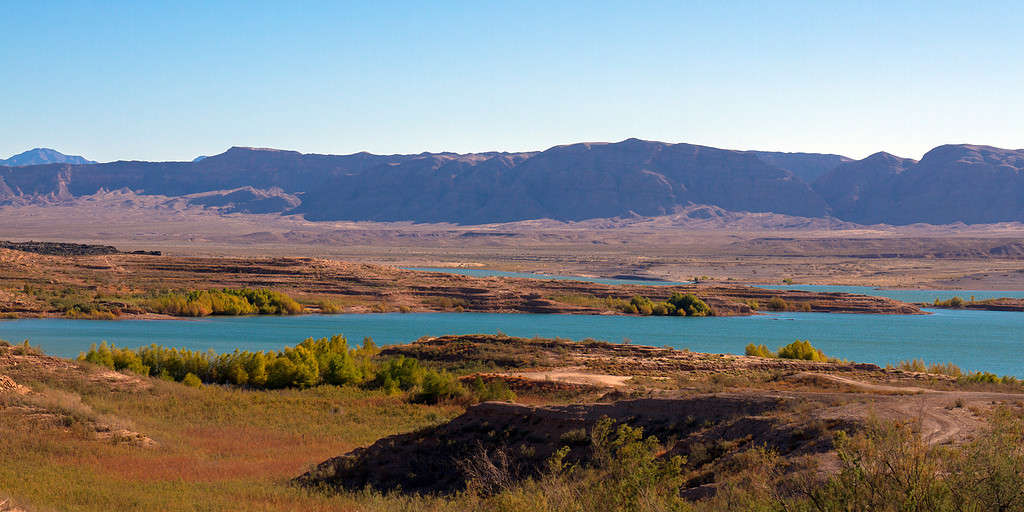
The Gypsum Cave Mine can be accessed from a remote, unpaved road close to Lake Mead.
©Martha Marks/Shutterstock.com
Once a uranium mine in Clark County, the Gypsum Cave Mine is now open to the public for exploration. Within the mine, uranium, anhydrite, and gypsum were all excavated, but today no concerning levels of uranium exist, so it’s safe to go in.
The limestone cave rests along a remote, unpaved road close to Lake Mead. Enjoy the cave and explore the history of the region where remains of giant ground sloths, horses, mountain sheep, camels, and prehistoric communities have been discovered. Then, head to the lake for a swim, boating, hiking, or sunbathing. The cave is open all the time.
Cave Rock State Park

An intriguing cave sits inside the picturesque Cave Rock State Park.
From sunrise to sunset, you can visit the incredibly beautiful Cave Rock State Park and the intriguing cave within. Cave Rock rests atop the Sierra Nevada mountains, with the largest alpine lake in North America. The crystalline waters make for the perfect boating spot, with multiple parking spots and a double ramp nearby. A small beach at the south end offers swimming and snorkeling or canoe launches.
The cave itself is a large rock formation, visible from almost any point on the lake. It rests along the southeastern shore, where once it was part of the volcanic vent in the area.
While visiting Cave Rock Park, you can participate in a number of activities and amenities, including:
- Picnicking
- Barbecue pits
- Boating
- Canoeing
- Kayaking
- Fishing
- Swimming
- Sunbathing
- Scuba diving
- Snorkeling
- Birding
- Wildlife viewing
Windstone Arch or Fire Cave

Walking through beautiful Valley of Fire State Park, Nevada, USA. Here, you’ll find Fire Cave or Windstone Arch to explore.
©Mirjam Claus/ via Getty Images
Known as either the Windstone Arch or the Fire Cave, this small cave tucked into the Valley of Fire should provide you with some thrills. The unusual sandstone formations surrounding the spot create the distinctive cave. Most folks recommend coming at sunrise for the glorious natural light show from the sun.
Mary Jane Falls Cave
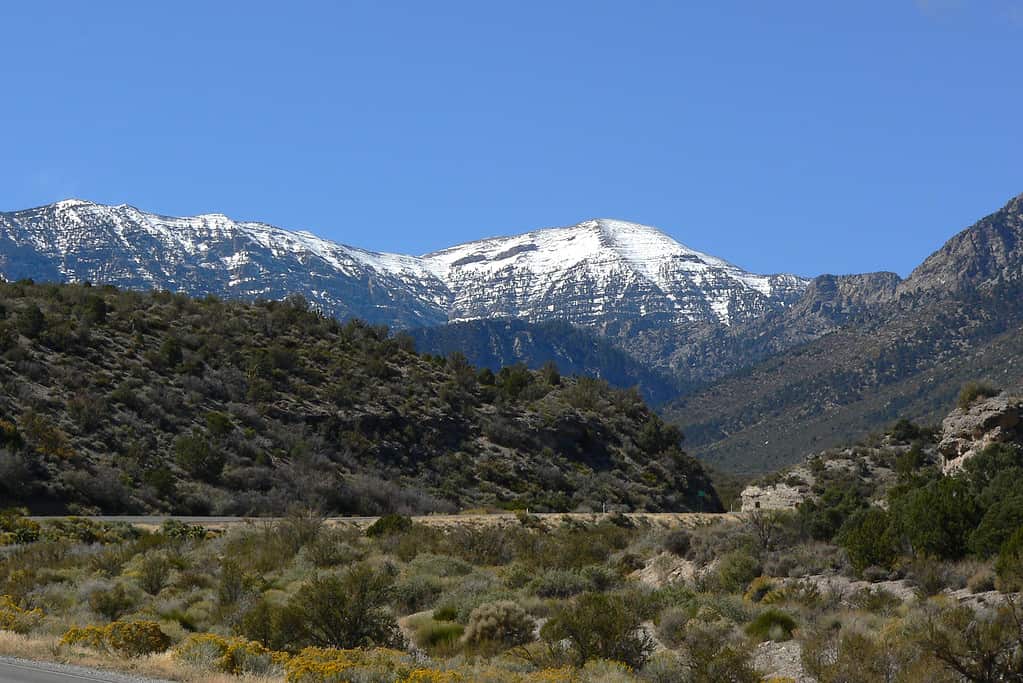
Mary Jane Falls sits in the heart of Kyle Canyon, Nevada.
For fit-bodied individuals only, the Mary Jane Falls Cave offers some excitement. The unique cave behind the 200-plus foot tall waterfall offers some incredible views of the falls and the surrounding landscape from within. The trail leading to the cave provides plenty of challenges for hikers.
Devils Hole

Inside Devils Hole, a limestone cave, sits a geothermal pool.
If a geothermal pool inside a limestone cave sounds like an intriguing spot to visit, head to Devils Hole. The site rests within the Ash Meadows National Wildlife Refuge, open and accessible every day of the week. A species found only in this spot is known as the Devils Hole Pupfish. You can’t actually go in, for the safety and protection of the pupfish, but you can observe the site and the fish from an overlook. Close surveillance keeps watch over the spot to ensure their safety.
Nearby, you’ll find other pools where other species of pupfish swim. You could also spot some of the exciting wildlife, as well, like coyotes, bighorn sheep, Cooper’s hawks, and white-tailed antelope squirrels. The meadow actually contains the highest concentration of endemic species in the United States.
Leviathan Cave
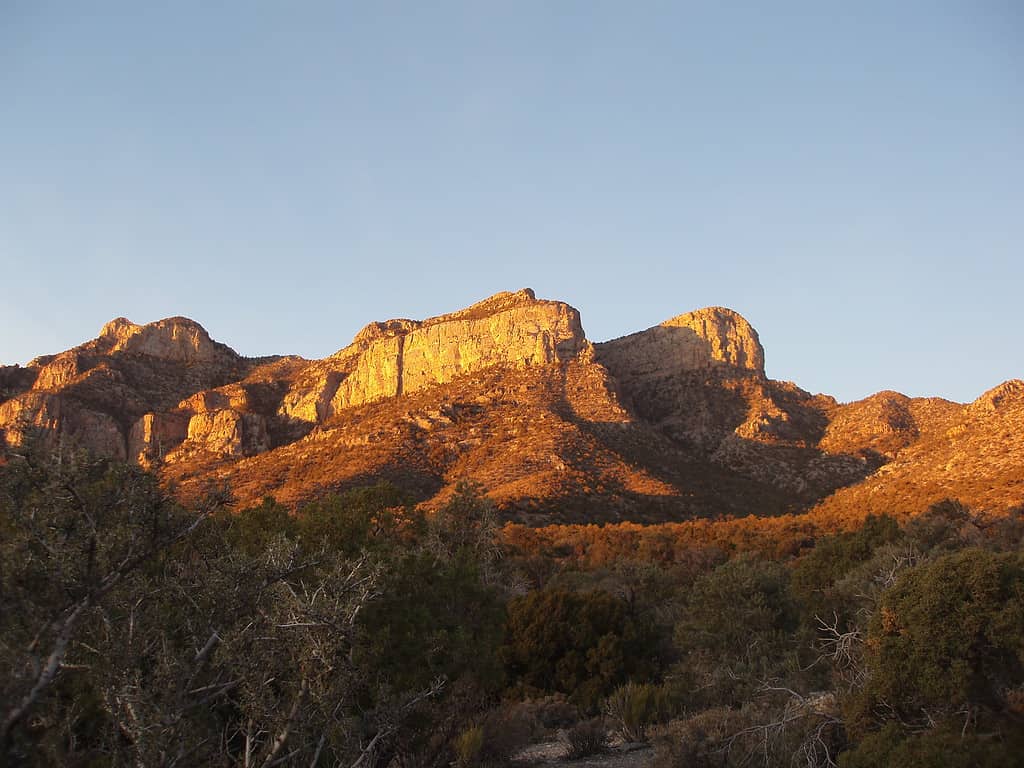
Leviathan Cave is located in the Worthington Mountain Range.
Resting within the Worthington Mountains, near Rachel, Nevada, the Leviathan Cave calls for exploration. The limestone formations require hiking through rugged terrain to access them, but once you’re there, you’ll spot a sinkhole entrance with ropes and a metal ladder leading downward. Tight passages await, so bring your flashlight and wear tightly-fitting clothing to avoid getting snagged. When you explore within, you’ll find sights of stalagmites, soda straws, flowstone, a rimstone pool, and other intriguing formations.
Other, smaller caves also surround Leviathan Cave on the hiking trails nearby. Look carefully for entrances and you could make a full day of exploring the caves in Nevada. Access is available 24 hours a day.
Humboldt and Lovelock Caves
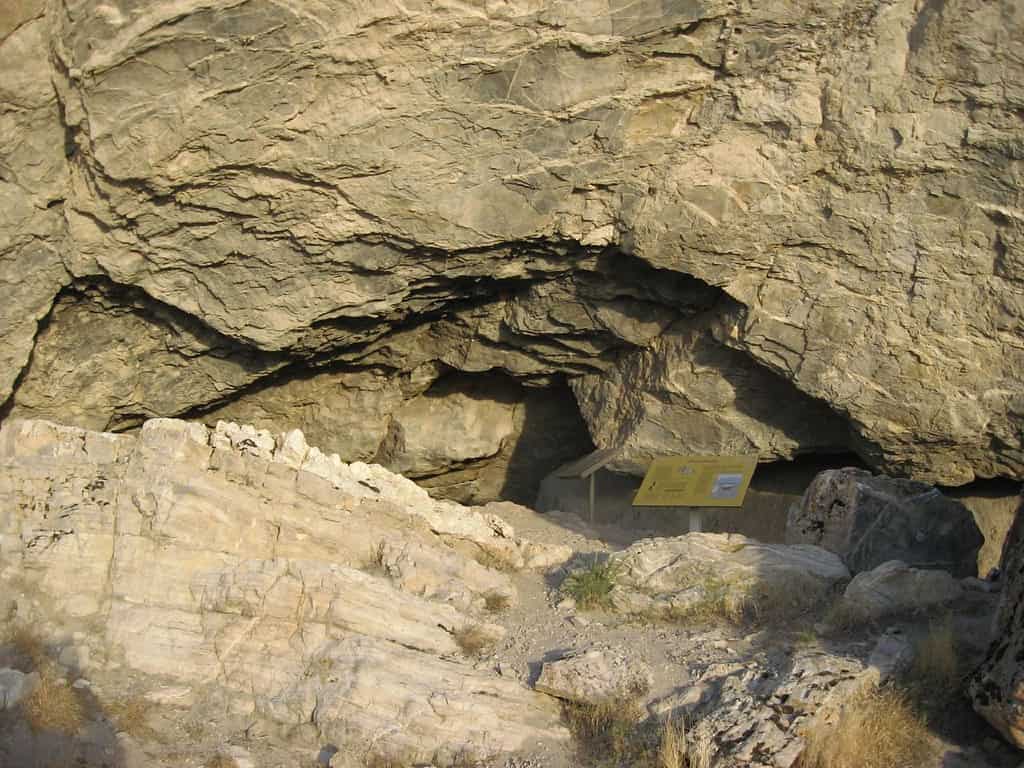
The fascinating Lovelock Cave doubles as an archeological wonderland. Inside intriguing artifacts were discovered, dating back as far as 9000 years or more. Just one of the exciting caves in Nevada to explore!
Tucked into Churchill County, Nevada, the Humboldt and Lovelock Caves doubles as an archeological site and intriguing place to explore. The cave was added to the National Register of Historic Places in 1976. Early Lovelock Paiute Tribe and the people of the Humboldt left behind evidence dating back to around 9000 B.C.E. The first known excavations of the area began in 1936 when Robert F. Heizer discovered artifacts in good condition in the area. There are no tours or special hours for visiting the caves. While you’re visiting, be sure to check out the Lovelock Cave, Humboldt Cave, and Humboldt Sink, the remains of Lake Lahontan.
Summary of 10 Incredible Caves in Nevada
| Cave | |
|---|---|
| 1 | Lehman Caves |
| 2 | Spirit and Hidden Caves Archaeological Site |
| 3 | Toquima Cave |
| 4 | Gypsum Cave Mine |
| 5 | Cave Rock State Park |
| 6 | Windstone Arch or Fire Cave |
| 7 | Mary Jane Falls Cave |
| 8 | Devils Hole |
| 9 | Leviathan Cave |
| 10 | Humboldt and Lovelock Caves |
Thank you for reading! Have some feedback for us? Contact the AZ Animals editorial team.

